
Posted on 02/14/2005 5:29:01 PM PST by Quix
GREETINGS,
[The following posts are from the JAN/FEB BIBLE CODES DIGEST. I have their standing permission to post them on FR. The one to follow this one is an interesting discussion of codes seemingly about the “Da Vinci Code.” More to follow . .[“QxEmph”= Quix emphasis added] Some paragraphing was added when original paragraphs were long and included more than one significant topic.Quix]
Correspondence
Length of Bible Increases Chances
Your website stresses how unlikely it is that a cluster, such as the one found in Isaiah 53, would occur by chance, especially since the coded phrases correspond so closely with the meaning of the surface text. However, considering that the Bible is quite lengthy, consisting of approximately 1,500 pages, is it really that unlikely for such a cluster to appear by chance in one or more places in the Bible? Clearly, the longer the text, the greater the chances are for such anomalies to occur. If every page of the Bible contained such clusters, your premise would be quite compelling, but they do not.
The way to test the chances of such clusters occurring is indeed to analyze other works, and see how often these cluster anomalies occur, compared to how often they occur in the Bible. You could also perform the experiment on several or more randomly selected books of shorter length (than the Bible), which together, equal the length of the Bible. If the combination of books has more pages than the Bible, exclude the extra pages in the experiment.
I agree that one should not disregard the significance of smaller clusters that are also improbable, even though they are not as improbable as the Isaiah 53 cluster. The probability question is really this: What are the odds that all of the clusters found in the Bible, with due regard for their various lengths and densities, would occur in a text as long the Bible, (i.e., having the same number of letters as the Bible)? More generally, the question is: What does all of the data taken together tell us?
I am very anxious to read your new book!
Craig W. B
Wadsworth, OH
Director [of the “Isaac Newton Bible Code Research Society—publishers, originators of the BCD] Ed Sherman's Reply:
Thank you for your very thoughtful questions. We have tested a non-Biblical text, a Hebrew translation of Tolstoi’s novel, War & Peace, and have measured the probability of finding ELSs of different lengths within a non-encoded text, given how many ELSs have been searched for. This analysis [Link here: http://www.biblecodedigest.com/page.php/186 SEE POSTED BELOW THIS CORRESPONDENCE], along with parallel analyses of the Bible, form the basis of our claims.
You will find as you read the book that we deal with the question of text length carefully and, we believe, appropriately.
Your proposed probability question at the end of your e-mail is excellent theoretically, but is not feasible. The problem is that no program exists to do what you propose—because it would require, at a minimum, a program with the ability to take any string of Hebrew letters and to determine the longest portion of that string that represented intelligible, grammatically correct Hebrew phrases and/or sentences that appeared sequentially within that string. And it would also have to provide reliable translations of all the optimally lengthy strings from Hebrew to English.
Absent such a program, we must settle for the drawing of samples, the employment of a Hebrew expert and the application of probability estimation techniques. That is what we have done, and the results from the samples we have drawn from the Bible are so far beyond what chance could produce from a non-encoded text, that we should conclude that coding exists in the Bible.
Abstract
A set of 100 equidistant letter sequences (ELSs) were drawn, equally from the Hebrew text of the book of Ezekiel and a control text (a Hebrew translation of Tolstoy’s novel War and Peace). Each of these initial ELSs (that was the name of an Islamic nation) was reviewed for possible extensions by a Hebrew expert who was blind regarding the source text of each letter string. The number of extensions discovered in Ezekiel was more than 50% higher. A Markov chain model based on the indicated extension discovery rate from the control text (19.4%) was used to determine the expected range in the number of ELSs consisting of three or more extensions that would be discovered from the search for possible extensions around 295 initial ELSs in Ezekiel 37. Although only 5.95 ELSs consisting of three or more extensions were expected, 33 were actually discovered. The greatest number of ELSs with three or more extensions produced from 1 million trials of the Markov chain model simulation was 21. It is evident that the null hypothesis that the Ezekiel 37 findings were due to chance should be rejected.
A similar comparison was made assuming the much higher discovery rate (27.0%) indicated from the Ezekiel text of the Islamic Nations experiment. The null hypothesis was still rejected at the 0.001 level.
Introduction
In 1994 the paper, "Equidistant Letter Sequences in the Book of Genesis," was published in the journal Statistical Science. In it three Israeli mathematicians, Dr. Eliyahu Rips of the Hebrew University of Jerusalem, Dr. Doron Witztum and Yoav Rosenberg of the Jerusalem College of Technology, [QxEmph] described the results of an experiment in which the proximity of such sequences (ELSs) for related topics tended to be in closer proximity in the book of Genesis than in randomized re-orderings of that text. The ELSs studied were the names of 66 of the most famous rabbis in Jewish history and their dates of death or birth. ELSs are formed by eliminating the spaces between words in the Hebrew text of the Old Testament and then by selecting every n-th letter from the compacted text, where n is the skip of the ELS. For example, within the letter string n e w j e r s e y, "wes" is an ELS with a skip of +2 and "sewn" is an ELS with a skip of –2.
Once an initial ELS such as "wes" has been found at a given skip, an extended ELS can be sought by continuing to extract letters from the literal text at the given skip of the initial ELS. From the sentence, "People say New Jersey was wonderful," the following search string around the "wes" ELS is extracted:
The word "yawn" appears after "wes" in the string, but this is rejected as a valid extension since it doesn’t form a proper phrase in English. If the second to the last letter in this string had been a "d" instead of an "f," "yawned" would have been a valid extension of the "wes" ELS.
In 1997 Michael Drosnin authored the book, The Bible Code, which topped the New York Times best seller list for many weeks. An atheistic Jew, Drosnin claimed that the Bible was filled with ELS codes about numerous current events and that this was proof that some super-human intelligence who knew the future, had written the Old Testament.
Numerous mathematicians have argued heatedly that the Witztum Rosenberg Rips paper was flawed while others have staunchly defended it. [QxEmph] Drosnin’s book was repudiated by Dr. Rips, and dozens of mathematicians, since it presents dozens of trivial examples that are so simple that comparable examples could be extracted from any Hebrew book or random sequence of Hebrew letters.
Four years ago Mr. Sherman began examining this phenomenon, strongly suspecting that there was nothing to it. [Qx Emph] After developing formulae to estimate the probability of chance occurrence of different purported Bible code phenomena, he concluded that virtually all examples from published books were not at all improbable. A few published examples were borderline in terms of improbability, so the help of a Hebrew expert, Dr. Nathan Jacobi 2 , was sought to enable the search for more extensive ELSs in the same vicinity as the published examples of Hitler codes from Genesis 8 (from Drosnin) and Jesus codes from Isaiah 53 (from Christian author Grant Jeffrey). Dr. Jacobi discovered numerous lengthy ELSs in the Isaiah 53 cluster.
Mr. Sherman was forced to reverse his negative position on Bible codes, which he had been presenting on a website, and he changed the site to biblecodedigest.com. During April 2003 this website received 1.3 million hits as the result of interest generated by the war in Iraq and the posting of hundreds of ELSs regarding current events on that site.
In the past two years our research team has located over 120 lengthy ELSs by starting with short initial ELSs of key words about current events, centering on the terrorist attacks and related developments, that are all located in the 37th chapter of Ezekiel. The initial formulae were too simple to gauge the probability of chance occurrence of a code cluster as extensive as the one in Ezekiel 37, so another estimation approach was developed and applied. It is presented in this paper.
The Islamic Nations ELS Extension Experiment
To directly address the question of the purported validity of Bible codes, there has been a clear need for an impartial comparison of a collection of Bible codes with a parallel set of codes from an admittedly ordinary book. This paper presents the results of this experiment. Dr. Jacobi was given 100 pre-defined initial ELSs, equally drawn from the Hebrew text of Ezekiel and from a Hebrew translation of Tolstoy’s War and Peace. Dr. Jacobi searched for extended ELSs around each initial ELS—absent any knowledge of the source of each letter string. The two collections of extended ELSs were then compared and analyzed. This is the first such experiment of this type we have conducted.
Using the Hebrew spellings of a group of Islamic nations3, INBCRS researchers 4 located ELSs (with the five shortest skips) of these names of nations in a 78,064-letter portion of War and Peace and the 74,500-letter book of Ezekiel 5 provided with Codefinder software 6 .
Dr. Jacobi was sent five occurrences with the shortest skips from Ezekiel (and five occurrences from War and Peace) of the name of each of the Islamic nations as an ELS. He was asked to document whether letters before and after the terms created longer terms. Throughout the experiment, and up until June 2003, Dr. Jacobi has not known which of the initial ELSs and surrounding letter strings were from which source text.
The experiment was conducted from August 2002 through January 2003 by intermittently including portions of both sets of letter strings. Dr. Jacobi never knew when we started doing so and when we finished. We continued to submit to him our regular supply of letter strings from other parts of the Bible on other topics as part of a number of research projects. His task was always the same—to indicate whether letters before and/or after the terms created longer terms. During that period approximately one-third of letter strings he examined were part of the experiment.
All ELS extensions found around 50 initial ELSs in Ezekiel and 50 initial ELSs in War and Peace were examined and recorded. An extension is a phrase or brief sentence that appears entirely on one side of an existing ELS. The extension must represent a grammatically reasonable continuation of the existing ELS. As such, it could either incorporate part of the existing ELS or be a stand alone phrase or sentence that could reasonably precede or follow the existing ELS.
The average extension found in this experiment consisted of two Hebrew words that totaled seven letters. It is of course possible to find several extensions around an initial ELS to form one lengthy final ELS. For example, the following 53-letter-long ELS from Ezekiel 37 was formed by eight extensions found around the initial ELS of the Hebrew word for "combat":
1) The island was restful, elevated
2) and it happened.
3) Where is Libya?
4) And you have disrupted the nation.
5) She changed a word.
6) He answered them with combat.
7) Why the navy
8) and the smell of the bottom of the sea?
Table 1 provides a comparison of the search results on three different bases.
Appendix A provides a listing of all ELS extensions found in both search texts.
A key statistic estimated in this experiment is the ELS extension discovery rate. It is defined as the ratio of the actual number of extensions found to the number of opportunities available for finding an extension. At the beginning of each search of a new letter string, there are two opportunities to find an extension—one before the initial ELS and one after. If an extension is found, one new opportunity to find yet another extension is created. That opportunity will consist of the new letters that are now next to the extension that had just been discovered. There is no new opportunity on the other side of the ELS where an extension wasn’t found, since that opportunity has already been counted.
The discovery rate in the control text was 19.4% (=24/124). In Ezekiel, it was 27.0% (=37/137), which is 39.2% higher7. A standard statistical test of the null hypothesis that there is no difference in the underlying discovery rates (proportions) indicated that there was a 12.35% probability that the indicated difference could be due to chance. Therefore, the null hypothesis held up at the 0.10 significance level.
It has been our observation in the last four years of investigation that, if anything, the difference in the discovery rates is generally greater than the 8.1 %-age points indicated in this experiment, and appears to be in the range of 10% to 15%. If the 8.1 %-age differential were to hold up under a larger sample of initial ELSs, then the probability of chance occurrence of a differential as large as 8.1 % would drop below standard thresholds.
For example, if the names of 82 (rather than 50) Islamic nations were included in the experiment, the differential were to remain at 8.1%, then p would drop below the 0.05 significance level. If the names of 140 Islamic nations were included, p would drop below the 0.01 significance level. This possibility suggests the potential value of expanding the sample size in an enlarged version of this experiment. Of course, it is possible that the addition of more initial ELSs might result in a diminution of the differential.
The possibility that differences in letter frequencies between the two texts might account for some of the difference in discovery rates was considered. A visual comparison of the individual letter frequencies indicated a very strong similarity between the two texts. The correlation between the two sets of frequencies was quite high (0.964827).
The services of another Hebrew expert, Moshe Shak, a Canadian engineer, were retained to investigate the degree to which the indications might be affected by differences in translations between Hebrew experts. The results are displayed in Table 2.
The discovery rate from Shak’s War and Peace extensions (18.7%) was very close to, but somewhat lower than, that from Dr. Jacobi’s extensions (19.4%).
1 R. Edwin Sherman is a Fellow of the Casualty Actuarial Society and a Member of the American Academy of Actuaries. He received a B.A. and M.A. in Mathematics from the University of California at San Diego, and passed three Ph.D. qualifying exams. He has 30 years of experience as a consulting actuary in serving numerous Fortune 500 corporations, major public entities, law firms and insurance companies in applying probability, statistics and econometric forecasting to risk management problems. He was a Principal with Pricewaterhouse Coopers, the world’s largest accounting and consulting firm, for seven years. He has authored five professional papers in actuarial journals and over 70 articles in trade publications. He directs the biblecodedigest.com website. 2Dr. Nathan Jacobi was educated in Biblical and contemporary Hebrew in Israel. He holds a B.Sc. in Mathematics and an M.Sc. in Physics from Bar-Ilan University. He received a Ph.D. in Physics from the Weizman Institute of Science. He has over 20 years of experience in research, development and scientific computing in applied physics, aerospace and geophysics. He currently teaches an intermediate Hebrew class in Ashland, Oregon. 3Algeria, Abu Dhabi, Bahrain, Dubai, Kuwait, Lebanon, Libya, Qatar, Somalia, Sudan and Yemen. Major islamic nations (Iraq, Iran and Saudi Arabia) were excluded because they had already been the subject of ELS extension searches in the book of Ezekiel. Originally only 10 nations were selected. However, for two of them less than five total ELSs were found, so Somalia was added to bring the total number of ELSs examined up to 50 for each text. 4Isaac Newton Bible Code Research Society. Researchers included Mr. Sherman, Dr. Jacobi and Mr. David Swaney. 5The final search text used extended from Jeremiah 51:52 through Ezekiel to Hosea 1:9. The last chapter from Jeremiah and the first chapter of Hosea were first added to expand the search text, and then as many final verses from the second to last chapter of Jeremiah were added as were needed in order for the Ezekiel Plus search text to have the same size (approximately) as the War and Peace search text. 6www.research-systems.com. 7The 39.2% differential for the discovery rates is lower than the 54.2% differential in the total number of extensions. This occurs because the denominators of the two discovery rates are not the same. Each new extension opens up a new opportunity to find yet another extension. Hence, there were many more opportunities to find new extensions in Ezekiel because more extensions were initially found in Ezekiel.
CONTINUE AT:
Please read the rest of the article here: http://www.biblecodedigest.com/page.php/187
The sages of old exhorted that we should "turn the Torah over and over," as there is no end to its study. No matter how many times we examine, analyze, and discuss it, there is always something more profound to be discovered, something new to be gained from the Torah. Also, in the Midrash (Sifre - Deut. 48) it is stated "like wine, the Torah pleases the heart and improves with age." Thus, there is much good and delight contained therein — for those studying Torah for the first time, and for those who renew themselves over and over in its wisdom.
You may be already familiar with the first line of the Sefer Yetzirah which clearly invokes this paradoxical relationship "...And He created His universe with three books (SeRaFim), with text (SeFeR), with number (SeFaR), and with communication (SiPuR)." (trans A. Kaplan)
Thus numeric value and letter form a sphere (note: SFeRe) of a cipher which fuse together into a single SeFiRaH (emanation) radiating congruent communication with the billiance of a "SaFiRe". Within this sphere, these two components are SePaRate and form an internal SFaR (border). As you can see, these root letters give expression to the entire concept. You may recall how the letters of the root for Kabbalah fulfilled the same function.
Indeed, this delicate paradoxical relationship creates a mental hurdle. Perhaps, an analogy to the properties of light will help to cross this obstacle. Depending on circumstances, light can take on the characteristics of either particle or wave. While we know this "impossibility" to be true and accept this perplexing fact, it is virtually impossible to visualize HOW this can be! (Unless you are a gaon of a physicist.)
As we contemplete letter/number relationship in Hebrew, we must avoid one frequently drawn - albeit incorrect - conclusion regarding the gematria considerations. Even some well know Torah Scholars have expressed their belief that gematria interpretations are "ingenious (super-imposed) afterthoughts" of the proper text. To such skeptic, Torah interpretations which make use of the numeric dimensions of the words in Torah are not viewed as being inherent but rather post-factum. Therefore, they appear inherently suspect - possibly dangerous and, at best, only of limited value.
To me, it is more a matter of being fine-tuned into a particular frequency of Torah. To a person who is tone-deaf, the glorious sounds of a great symphony will forever remain hidden. Until we had the appropriate instruments, we only saw a very limited spectrum of light waves whereas the infra / ultra frequencies were beyond perception. Obviously, their existence did not depend on human awareness. I think of the numeric aspects of Torah as being in a realm of elusive frequency. Our chokhamim never doubted its existence, yet justifyably they entered it with greatest caution and cirumspection.
Due to the esoteric nature of this "inner geometry" of words and phrases, it is by all means conceivable to arrive at entirely incorrect conclusions if one were to not also bear in mind the overt meaning of Torah. Throughout the ages, Kabbalists have advised and cautioned to always keep the overt text clearly in mind. Proper gematria interpretations MUST NOT and CANNOT contradict the simple meaning of the story.
The mere fact that gematria elucidations could easily get on the wrong track (if not cross-checked) do not render them any more suspect or invalid than any other D'var Torah of the overt text. The risk of contradictory readings extends well beyond the realm of numbers. It is an inherent characteristic of the Hebrew language. Even the surface level of each story presents possibilities for incongruent readings. Consider the many possibilities of interpreting the Akedat Yitzkhak (Binding of Isaac). Could one arrive at an interpretation of this story that would be entirely un-jewish ?
Divrei Torah using gematria elucidations must be congruent and bring out the vibrant reality and deep truth to the surface. While it would be false to perceive such interpretations as fortuitous coincidences, it is inconceivable to attribute these secret, subtle frequencies to the individual human, intentional design. Granted, there are some quantitative aspects that may very well reflect human design intention such as the fact that the Ten Commandments always occupy 26 lines in a Sefer Torah. [26 is the gematria (numeric value) of the Tetragrammaton: yud-hey-vav-hey.]
Neither this introduction nor any of the texts should be taken as an attempt to explain naturally arising questions about the HOW, WHY, WHERE and WHEN. Certainly, a few texts such as these cannot suffice to fully demonstrate the astonishingly consistent numeric dimension that permeates Torah to its very letter. Gaining an appreciation of this fascinating face of Torah does not prove anything. A definitive explanation of these underpinnings of this reality may always elude us, but as with the paradox of light - we may behold its forceful presence, even if we cannot fully fathom its origin.
Finally, it must be said that our approach to learning Torah must be balanced. Gematria perspectives by themselves are indeed only of limited value if they are not part of a greater purpose. As esoteric as the numeric aspects of Torah can be, a great antidode to "going off the deeep end" is the regular practice of layning (chanting) Torah not to mention the performance of its mitzvot (commandments). With this in mind, enjoy the following texts.
More at...
Hmmmmm. Interesting food for thought.
Personally, I prefer to avoid anything close to Biblically proscribed numerology.
On this topic area, I'm wont to leave it to betters than I--such as Alamo-Girl and others.
But I appreciate the thoughtful post.
THX.
-------------------
Bible Code Digest--January/February 2005 continued
The Controversy Over Mosaics: Round Five Continued
Let There Be Light
In this issue, we present one of the most striking of Bauscher's intriguing findings based on wrapped text searches—again using a divine name for the ELSs to be examined. Bauscher has posted the results of a broad range of his research on his web site.
We will look at Bauscher's search results for the Hebrew word for light, OWR (Alef-Vav-Resh). The following graph provides a comparison of the Z-Values of the deviations of the actual number of occurrences from the expected number, for a full range of skip size categories.
The Z-Value is the actual difference divided by the square root of the expected number of occurrences. If the Light mosaic from the Peshitta behaved in the same manner as the Light mosaic from the control text, virtually all of the Z-Values would fall within the range of -3 through +3. And the Z-Values would randomly vary above and below zero. In great contrast to this, 27 of the 46 Z-Values (or 58.7%) from the Peshitta text fall outside the range of values from the control text.
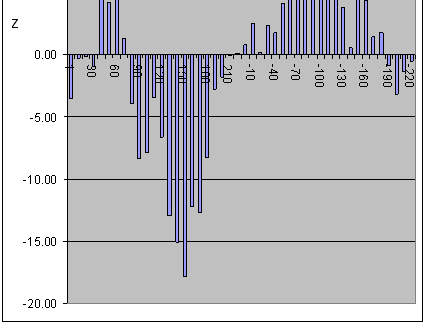
And the Z-Values form a wave pattern much like that of a light wave—which is most curious since this is the mosaic of the Hebrew word for light.
The next graph shows the results from the control text as a comparison. Its scale is the same as that for the Light mosaic graph from the Peshitta. Obviously, the control Z-Values are truly miniscule by comparison and are randomly positive or negative.

The above mosaics summarize comparisons of the differences between the expected and actual number of occurrences of the Light ELS in the wrapped Peshitta and a parallel control text. Within each, the Light ELS is expected to occur 130.3 million times—with skips of 1,000 or greater. Given the law of large numbers the Z-Values for nearly all the differences between actual and expected should fall between -3 and +3. Instead, the Z-Value for Light ELSs with positive skips is -20.58.
Such a Z-Value is so far outside the range of results anticipated for random phenomena that we should conclude that it cannot be due to chance. And the Z-Value for Light ELSs with negative skips is +24.21, even further outside the range of expected results.
In contrast, the corresponding Z-Values for the control text are quite small (+0.36 for Light ELSs with positive skips, and -0.21 for negative skips.

In considering the size of the radical departures from random behavior exhibited by the Light mosaic in the Peshitta, it should be emphasized that by using a wrapped text, any bias due to differences in letter frequencies between various parts of the text has been eliminated. And yet, this powerfully striking mosaic exists!
The next table shows the specific differences between the actual and expected number of occurrences of the Light ELS for the entire range of skip sizes. The values in this table directly correspond to those in the above graphs, except that the differences have been converted to Z-values. For each of the skip size ranges, the expected number of occurrences of the Light ELS is 2,845,167. An exception is the first skip size range, which is smaller, ranging only from 1,000 to 10,000—while all of the positive skip size ranges are 10,000 wide. Another exception is the first negative skip size range (i.e., that for -1,000 to -10,000). For each of these, the expected number of occurrences of the Light ELS is 2,560,679.
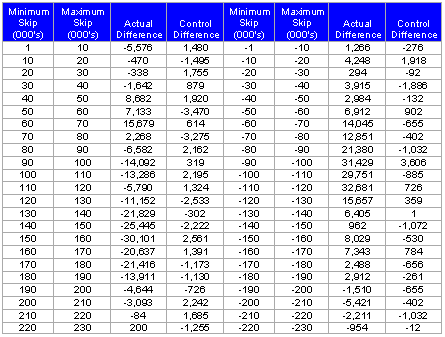
[TO BE CONTINUED]
This section is about a fascinating discovery in view of all the hoopla about the hoax called THE DA VINCI CODE. It is the last of several earlier [in this Digest--see the website] sections exploring what appears to be an authentic Bible Code clueing the reader in that the Da Vinci Code is fraudulent. Thx, Qx -------------------
Bible Code Digest--January/February 2005 continued
Appendix: A Table of Terms About The Da Vinci Code
> Researched by Moshe Aharon Shak
Copyright © January 2005 by Moshe Aharon (Morris) Shak
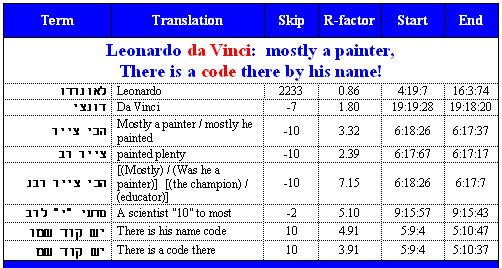

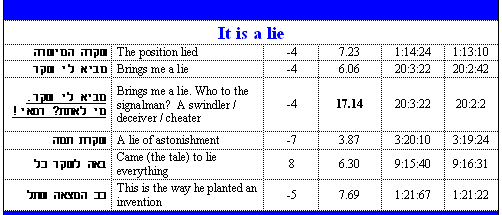
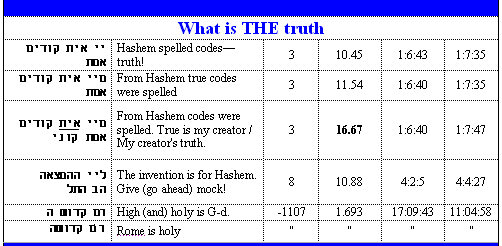
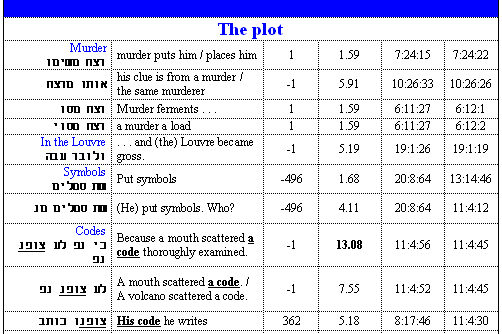

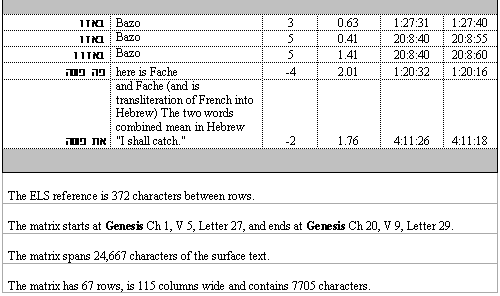
Note: *The serious Bible Code student should review the September 2004 issue of the BCD. In my article, "What is a code" under the section "What's in a name." I discuss the issues of using names in a matrix. The name Leonardo, the key term in this matrix, appears in the matrix as it is commonly used. On the other hand, a name like Robert is typically spelled with a tet not a taf. On the Internet for example, you will find 24 Roberts with a taf, as opposed to many thousands with a tet.
From my perspective, the matrix produced significant results without the list of heroes. With the exception of Mary Magdalena, the fictitious names are not relevant—in my opinion. The question of should we or should we not consider them is still an art in my view. Unfortunately, so many people will use any transliteration to "scientifically prove" a code.
Return to the first page of the January/February Digest where the Da Vinci Code discussion begins-- by clicking here: http://www.biblecodedigest.com/page.php/284.
Copyright ©2005 biblecodedigest.com All Rights Reserved
The Bible Code Digest is a publication of the Isaac Newton Bible Code Research Society. No part of this newsletter may be reproduced or used in any form or by any means, electronic or mechanical, including photocopying, recording, or by any information storage or retrieval system, without permission in writing from the publisher. Subscribers may forward to one recipient without seeking permission from the publisher.
The Bible Code Digest is published by a group of scientists and writers dedicated to a search for the truth. Our goal is provide accurate, unbiased reporting of news about cutting edge Bible code research conducted by our own group as well as by other credible researchers. We endeavor to report on the significant findings of Jewish, Christian and secular researchers, regardless of their views regarding the potential validity of some Bible codes. We present a variety of viewpoints on Bible codes and often accompanying spiritual matters in these web pages, but we don't necessarily agree with all of them. Our view is that God created codes in the Bible because He loves us and wants to show us another facet of His omnipotence and omniscience.
Inquiries may be addressed to BCD Director Ed Sherman at
info@biblecodedigest.com.
Thanks for the additional information!
HMMMMMMMMMMMMMMMMMMMMMMMMM.
Obviously due to chance alone. /sar.
Revelation 13:18 Here is wisdom. Let him that hath understanding count the number of the beast: for it is the number of a man; and his number is Six hundred threescore and six.
You know the answer to your question before asking it.
Which indicates that you asked it to make a statement rather than to get an answer.
Not so cute.
Hiya quix ol' pal!
Thanks for the heads up. I find myself closer in agreement with the poster awhile back....that if these code studies can help skeptics come closer, or come to any saving relationship with Jesus, then I'm for it.
Seeing thru a glass darkly as we do now, well, even in eternity, I don't think we could ever fully know God. That's my idea, anyway. One thing I noticed from the tables(?), is a mention of "Rome is holy" (IIRC).
Not wanting to start a fight or anything, but that makes me a little (ok, more than a little) leery.
i UNDERSTAND.
I had more similar wary-ness in the earlier years of the code explorations. But as I've observed it over the years, it seems to me--that the valid codes are often enough like many Scriptures. VERY CRYPTIC.
"Rome is holy" could easily mean
--Rome is holy to many believers
--Rome is seen as holy by many believers
--Rome holds itself out as holy
--. . .
Like Scripture--no isolated Scripture can be wisely taken out of context--at least not most.
Certainly the same is at least as true about the codes.
Like much of Scripture--most Scripture--I see the Codes as encouragement for believers and provocative to unbelievers.
Even Scripture does not give us exhaustive and crystal clear exhortation about many issues of our daily lives--even important issues. Scripture doesn't outline which spouse to marry; car to buy; house to buy; vacation destination to take; new job to take.
Much of Scripture is mysterious in at least some of it's meanings. Holy Spirit is needed to lead us into all truth even with Scripture.
Part of God's nature seems to delight in giving us puzzles to ponder. I think the valid codes fall at least in that category.
THANKS MUCH for your kind reply.
Here's a start (took all of one minute with a Google image search):

It’s inescapable, here’s a (very) basic example…
Most are familiar with this verse…
Revelation 13:16
He also forced everyone, small and great, rich and poor, free and slave, to receive a mark on his right hand or on his forehead…
Exodus 13:16
And it will be like a sign on your hand and a symbol on your forehead that the LORD brought us out of Egypt with his mighty hand."
***
Two very different marks but the same chapter and verse number. I have my Fathers mark because I observe Pesach and Matzos. The Revelation mark comes from bowing to Mecca.
048.029
PICKTHAL: Muhammad is the messenger of Allah. And those with him are hard against the disbelievers and merciful among themselves. Thou (O Muhammad) seest them bowing and falling prostrate (in worship), seeking bounty from Allah and (His) acceptance. The mark of them is on their foreheads from the traces of prostration. Such is their likeness in the Torah and their likeness in the Gospel - like as sown corn that sendeth forth its shoot and strengtheneth it and riseth firm upon its stalk, delighting the sowers - that He may enrage the disbelievers with (the sight of) them. Allah hath promised, unto such of them as believe and do good works, forgiveness and immense reward.
http://www.usc.edu/dept/MSA/quran/
The god of forces is also worshipped by many without their recognizing its source.
The ones you presented were (across the top row) L K K (or Kh).
Sorry I'm slow to understand, just don't get it.
http://www.torahtots.com/alefbet/nekudot/abtable.htm
Don't forget to add up the sum!
With regard to post 22 and the subsequent:
Kabbalism has become a subject of new age mysticism. The actual, ancient Jewish Kabbalah is quite something else. It literally means a tradition of knowledge passed down verbally over the millennia since Adam.
But here’s the rub, the actual Jewish Kabbalah is shrouded in secrecy because the power is much too great for mere mortals. We could wreck havoc – and that is not a metaphor.
Personally, I don’t seek to know the when or where or how God’s plan will be consummated. The “signs of the times” are enough for me. That His will is done is the important part – and it is also assured, so I’m a “happy camper”.
EXTREMELY WELL SAID, imho.
I greatly agree. THX.
After viewing: What do you make of this?
Disclaimer: Opinions posted on Free Republic are those of the individual posters and do not necessarily represent the opinion of Free Republic or its management. All materials posted herein are protected by copyright law and the exemption for fair use of copyrighted works.